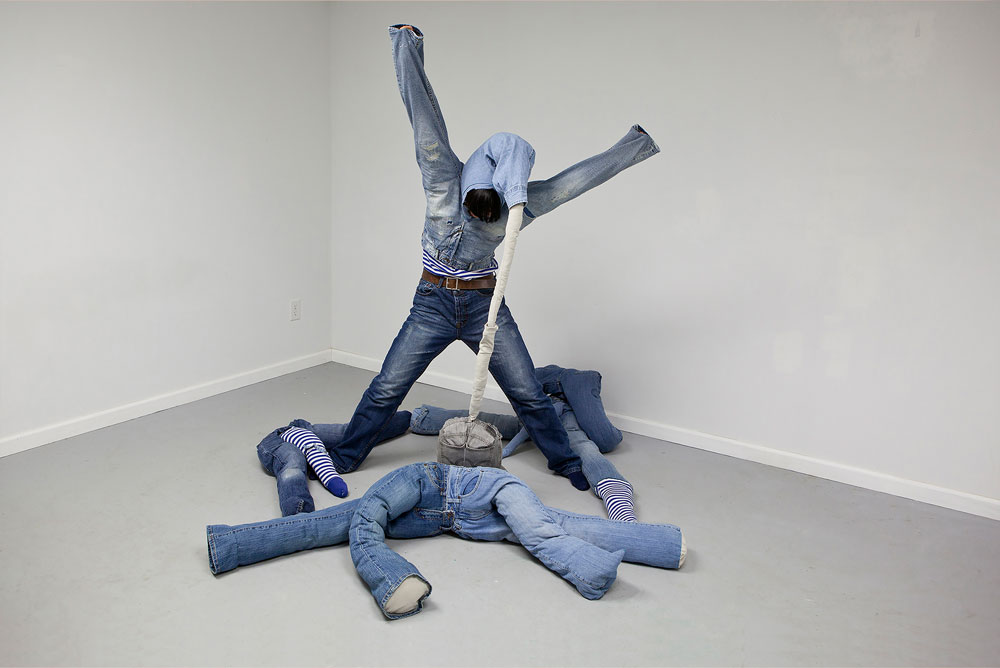“Through art, I weave stories of time, memory, and identity, inspiring small steps toward a collective transformation.”
While much in my life has changed, my passion for creating art remains constant, anchoring me to my roots and shaping
Born: Hailar, the “Pearl of the Grasslands”, Inner Mongolia
Now: New York, United States
@ellenjingxu | ellenjingxu.com
INTERVIEW
You often address themes of time, reality, and memory. Which of your projects best reflects these concepts?
Every project I create feels like part of a larger puzzle, but #8510: The Space Between Us stands out. Created during my residency at the Newport Art Museum, this installation draws from my childhood memories. I used red paint and marker drawings on popsicle sticks, creating a piece that is deeply personal.
The work not only reflects my current situation but also embodies a longing to revisit and change the past. A secret door within the piece symbolizes this desire for transformation. For me, this installation isn’t just visually powerful—it holds emotional weight, offering strength and courage to face reality.

Your projects often focus on changing perceptions of women’s identity. What societal changes would you like to see inspired by your art?
Growing up in a conservative family, I faced rigid expectations about what it meant to be a “good woman.” This upbringing instilled in me certain beliefs that I began to question as I encountered diverse environments throughout my life. These experiences allowed me to reshape my understanding of identity and gender roles, forming a crucial foundation for my art.
Art has been a vital tool in exploring and expressing this personal journey. Each stage of my work reflects my growth, and I hope it resonates with others, allowing them to see their own reflections in my experiences.
I want my art to spark conversations about identity and foster personal growth. When united, individual transformations can drive broader societal changes. This hope fuels my creative process and motivates me to create art that inspires empathy, understanding, and empowerment.

What inspired you to create “Second-hand sculpture”? Which audience reactions have been the most memorable for you?
The “Second-hand Sculpture” series emerged from my exploration of identity and its fluidity. I was fascinated by two ideas: embodying multiple identities simultaneously and how different contexts shape audience perception.
This led to three distinct approaches within the series. In one, I wear my sculptures, merging my identity with the work. In another, audiences interact with the sculptures by sitting on them while watching my videos, becoming part of the installation. Lastly, I create temporary “clones” of myself in public spaces using recycled materials, leaving the scene shortly after.
Children’s reactions stand out the most—they engage instinctively, without hesitation. These spontaneous interactions remind me of art’s potential to connect deeply and universally, often in ways that are surprising and inspiring.

Jing, how do you adapt your projects for an international audience, considering different cultural contexts?
As an artist who has had the privilege of living in both Inner Mongolia and New York City, I find myself continually navigating and embracing diverse cultural landscapes. This unique background enriches my creative process, allowing me to produce work that transcends specific cultural boundaries while remaining deeply rooted in my personal experiences.
Authenticity is at the heart of my art. When my creations stem from genuine emotion and thoughtful reflection, I believe they resonate on a universal level. I also strive to understand the cultural contexts where my work is exhibited, seeking out points of connection that can foster deeper engagement with my audience.

You have participated in numerous residencies. Which of these experiences has been the most significant for your growth as an artist?
Residencies are an essential part of my artistic journey, providing me with invaluable time and space to hone my practice. However, it’s the experiences that immerse me in new environments and communities that have proven to be the most transformative.
Programs like Skowhegan, Vermont Studio Center, and the Wassaic Artist Residency have opened my eyes to diverse perspectives and collaborative opportunities. The chance to engage with other artists has challenged my assumptions and pushed my boundaries, ultimately enriching my creative process.
Equally important are the connections I’ve forged during these residencies. The relationships I’ve built have been a significant source of support and inspiration, creating a sense of community that continues to fuel my growth as an artist.

What themes or directions do you plan to explore in the future?
My artistic vision centers on community engagement and extends beyond traditional gallery spaces. I believe in art’s power to inspire transformation and forge meaningful connections. Projects like Street Works Earth 2024 in Jackson Heights exemplify this commitment to social impact through collaborative art.
In my future installations, I seek to reimagine public spaces as interactive hubs for dialogue. My goal is to challenge conventional perceptions and encourage people to engage with their environments and each other in new ways. Ultimately, I aim to use art as a tool for empowerment and collective growth, fostering strong community bonds and sparking meaningful conversations.

If you could give advice to emerging artists, what would it be?
As an artist, maintaining a sense of curiosity and openness to new experiences is essential; after all, curiosity serves as the foundation of creativity. I believe in trusting my instincts while also embracing challenges and constructive criticism, as they are invaluable tools for personal and artistic growth.
I believe in trusting my instincts while also embracing challenges and constructive criticism, as they are invaluable tools for personal and artistic growth.